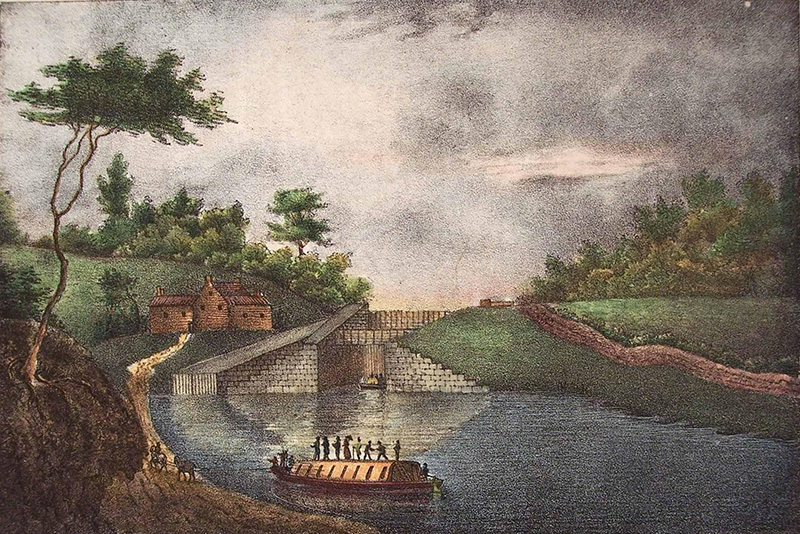The Resurrection of Andrew Weatherwax

Un texte de Heather Darch
Paru dans le numéro Été/Summer 2021
Publié le : 15 juin 2021
Dernière mise à jour : 18 juin 2021
Andrew Weatherwax whose body had apparently been discovered at the wharf in Pike River in early July of 1856 returned from the dead in 1867.
« Andrew Weatherwax known to have been murdered eleven years ago has returned from the dead. » The News and Frontier Advocate, Montreal and St. Johns, October 2, 1867
The story
The village of Pike River, Quebec, once known as Lower Falls, sits on the final rapids of the Rivière aux Brochets. From the early to mid 19th century, Lower Falls was a port for the transport of timber, cut boards, grain and other goods on barges that moved down Lake Champlain and to the Hudson River.
It is hard to visualize the scene, but in 1836 alone, nearly 270,000 boards and planks were shipped to the United States from this point. During the time period between the 1830s-1850s, the timber bearing regions of Missisquoi Bay and northern Vermont and New York, were so engaged in the processing of pine and balsam fir that there were fears that no trees would remain standing. Work for the bargemen was steady and carried on in a predictable rhythm at the wharf in Lower Falls until the summer day when a body of a man surfaced by the dockside.
Like so many people on both sides of the border, the Weatherwax family of Peru, New York, found work on boats connected to the timber trade. John German Weatherwax (1832-1921), was a man described as a “hearty, fearless fellow of fine physical proportions and dauntless spirit that would not brook contradiction.” He became the captain of a barge, which he conducted between ports on New York and Vermont shores, and across the line, to the ports of Philipsburg and Lower Falls. His cousin Andrew Weatherwax, aided him in the navigation of the vessel. It was in early July 1856, that Captain Weatherwax, attended by his cousin, sailed from Plattsburg, New York for Lower Canada.
Captain John Weatherwax
At Pike River, Captain Weatherwax was to obtain a load of timber. According to witnesses, the Captain and his cousin became embroiled in a violent quarrel while they worked to pack their boat. Observers were quick to say that both men were inebriated. The drinking and “wrangling” continued throughout the day and during the night. Witnesses said they heard “a dull heavy thud, as of a powerful blow with some heavy weapon crushing through a skull, and then all was still.”
On the next morning, Andrew Weatherwax was nowhere to be found. Captain John Weatherwax denied any knowledge of his cousin’s whereabouts and returned to Plattsburg. A week later however, the body of a man was discovered at the wharf where Captain Weatherwax had previously docked. The man had evidently come to his end by violence and the body was identified as Andrew Weatherwax. Captain John was arrested on the charge of murder and jailed in Plattsburg.
The trial
The prosecution hoped he would be found guilty and sentenced to hang. Weatherwax’s defence argued that because the crime took place in Lower Canada, neither the authorities of Plattsburg, Clinton County or New York, had any jurisdiction in the matter. He was released, but a formal requisition was made by the British government “to deliver up one John G. Weatherwax, accused of capital crime committed within the borders of Lower Canada, to be dealt with as directed by the laws he had violated.” He was taken to Montreal and confined in prison for over a year. In a trial by jury with Judge Thomas Cushing Aylwin presiding, he was acquitted on a lack of evidence and unreliable witness testimonies.
The resurrection
The story did not end there however, as the “murdered” Andrew Weatherwax returned from the dead in 1867! According to his own changeable account, he left his cousin’s boat only to be arrested for public drunkenness. Then was brought before a magistrate and fined. Not having the money to pay the penalty, he was to be imprisoned. But a man stepped forward and offered to take him as a deckhand. He gave him an advance of wages to pay the fine. He accepted, and was shipped out to Montreal. From there, he sailed to China, Australia, and to various ports of the world. When he returned nearly 11 years later, he even lived in Montreal for some time before he was “flabbergasted” to hear of his demise. No one was more shocked than Captain Weatherwax who apparently fainted at the sight of his cousin.
An unsolved mystery
There is still a mystery connected with this case. No rational account was given of the body that was floating in the river and misidentified. Incredibly, no one from the Weatherwax family ever identified the corpse. The story made the newspapers on both sides of the border. It also inspired Stanbridge East poet Erastus Chandler (1806-1884) to write a sympathetic poem called “John’s Trial,” about the circumstances of the accused captain and the cousin who rose from the dead.
Again was honest John arraign’d
Before Aylwin, a judge unstained, of Montreal
With one keen view of sterling sense
He saw thro’ all the false pretence,
Corpse, blood, and all
Our judge believ’d not in the “thud,”
And much less in the guess of blood.
Heather Darch
Sources:
Catherine Day, Pioneers of the Eastern Townships, Montréal 1863; Paige Knight, The Pike; a short guide to a small river, in Missisquoi Historical Society Reports, 1979-80; Charles Lussier, Profils historiques du bassin versant de la baie Missisquoi, 2004 http://www.obvbm.org/public/documents/documentation/index/actions/autres_publications/historique_bassin_versant_baie_missisquoi_2004.pdf ; Samuel March Phillipps, Famous Cases of Circumstantial Evidence: With an Introduction on the Theory of Presumptive Proof, Cockcroft: 1873; The Plattsburg American Sentinel, November 1, 1867 http://nyshistoricnewspapers.org/lccn/sn85026976/1867-11-01/ed-1/seq-1/; Erastus Chandler, A Few Things in Verse and Prose, Lovell: 1877; Lithograph by Charles Rind: View of the Northern (Champlain) and Western (Erie) canals, 1825 https://www.thehenryford.org/collections-and-research/digital-collections/artifact/229623#slide=gs-222601

